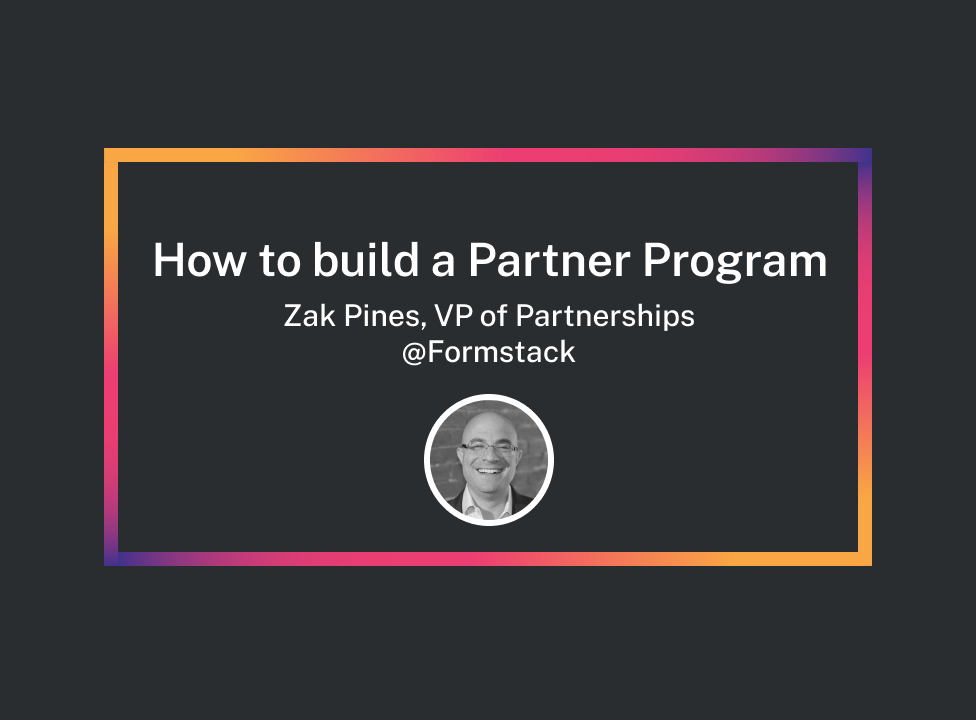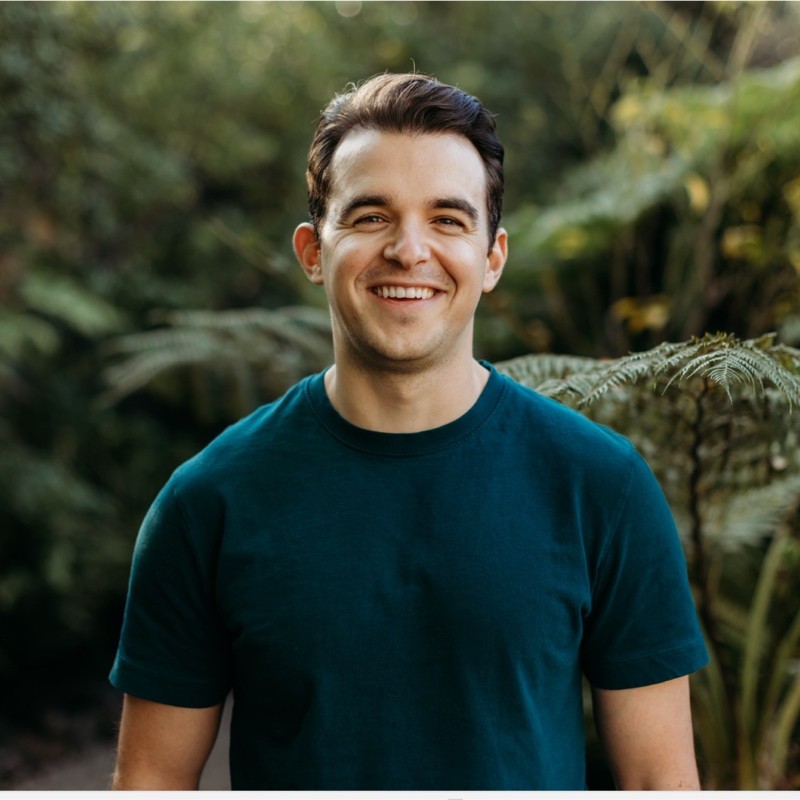Zak Pines lives outside of Boston and is VP of Partnerships at Formstack. During his 4 years at the company he has built a high growth, breakthrough partner program. In this article, Zak shares his experience and offers clear steps on how to build your partner program.

Why you should build your Partner Program
Partner Programs are a multiplier, they allow you to tap into a one-to-many growth dynamic. If you do your Partner Program the right way, it should be the top growth driver for your business.
Some of the foundational elements to the success of the partner program at Formstack have been:
- Defining our best partner persona
- Organizing teams around key areas
- Setting base metrics
- Establishing underlying systems
1- Define your Best Partner Persona (BPP)
You can’t boil the ocean so understanding what type of business makes a good partner will help you focus your efforts. In our case, that meant first defining the value of the partner team – building a motion to develop one-to-many relationships to drive customer acquisition. That meant consultants, marketing agencies, software companies, anyone that has their own set of customers.
As we got started with the Formstack Partner Program, we looked at which types of businesses were already working with us. Once you identify who is using your product, you can segment and identify them as potential partners.
The second step was getting to know our partners and potential partners. One of the very first things I created was a blog series called “The Partner Interview Series”. In those articles I featured consulting businesses, interviewed their CEO’s and power users. In some cases they were using Formstack, in some cases they weren’t but that didn’t matter since the goal was getting to know them.
Over the course of six months, I interviewed close to a 100 different consulting firms, potential partners and partners in our space and published that content. The insights I took from that experience, coupled with seeing how they were using the product, allowed us to identify the persona that was most successful for us. In our case, that persona was the Salesforce consulting firm. That became our target persona, specifically those that were small to mid-size, anything in between 1 and 500 people.
We knew that if we engaged those companies by working with them, teaching them to use our products and enabling them, that would lead to repeat collaboration and referral business.
Those interviews also gave me the foundational knowledge of product use cases by vertical that fueled our partner engagement from that point forward.
2- Organize teams around key areas
After defining your BPP, it’s time to organize your team. At Formstack, we initially tiered the team into:
- Partner acquisition
- Partner enablement, which we later changed to onboarding.
- Partner growth, which we backed up with additional partner enablement resources.
The partner acquisition team is in charge of everything to do with bringing partners in to engage with us. We do that through outbound and inbound techniques, like content and social media. Amanda Nielsen was our first partner acquisition manager and she leads that team today.
One of the mottos of our partner team is “enablement first”. That means leading with enablement, and that’s where the partner onboarding team delivers. They lead with product expertise to engage partners and help them use our products. Their goal is to build out, either a proof of concept or a real world customer implementation. That demonstrates they know the product and is the basis for becoming a certified partner.
At that point, the partner is handed off to our partner growth team. That team started as one person, Bryce DeHart, and has since grown to a team of five partner growth managers. This team actively works with partners in joint initiatives to grow with each other. They are backed by a partner enablement resource that provides continual product expertise for our partners. This is a way to make sure that our “enablement first” philosophy flows through the extended relationships between our companies. The north star of the partner growth manager is developing repeatable use cases with a partner, that feeds a repeatable set of customers whereby we and our partners are delivering joint value on a proven, vertically-specific use case.
Later on we added another aspect to our team, which we called Salesforce engagement, led by Shakil Kamran. Salesforce engagement is how we engage Salesforce as an organization and co-sell with Salesforce AEs and SEs.
3- Set base metrics
Once you start and expand partnerships, having a base set of metrics that you can track and measure is essential. In our case, the referral motion became the main motion of the business. Our “enablement first” message encouraged partners to bring us into opportunities, introduce us and log referrals in our partner portal. We also let them know that we were happy to do the heavy lifting from a selling standpoint around our products.
This process was modeled after a demand generation model, typically used to measure marketing effectiveness. We asked ourselves “How many opportunities are we generating from partners?”. We tracked the pipeline and conversion rates to close one deal and measured that against other acquisition channels to look at the performance of the entire partner referral motion.
The main metrics became the number of opportunities and pipeline generated and how much of that turned into recurring revenue. The number of certified partners also became a key metric because that showed how much we were bringing through that acquisition process, and feeding the partner growth machine.
Looking forward, we want to work on engagement. How do we measure partner engagement? How do we measure growth? What’s the best way to measure the activities that are leading to pipeline generation more systematically?
4- Underlying systems
Partner Programs involve a lot of data and it is very important to create the right underlying systems to manage it. That way your data is unified and you don’t create data silos across multiple systems.
In our case, the business had Salesforce as a CRM so it made sense for us to use that as a base product. We also have several Formstack products native to Salesforce, so that allowed us to create some quick wins. For example, Formstack for Salesforce has the ability to publish pre-filled forms at different steps in a customer or partner journey. So we started using them in our introductory meetings with new partners. We shared a link to a pre-filled form with all the partners information from his Salesforce account records. That way we provide an easier and smoother experience. The partner starts enjoying all the benefits we offer, like complimentary licenses to our products or enablement sessions with our teams, right away.
The other thing that we knew we needed was a referral management system because referrals were a central part of our strategy. We used PartnerStack for that because it’s a strong product, very specialized in referral management and tracking payouts.
The core of a Partner Program
A strong Partner Program also needs a core set of beliefs and values across the Partner team and the cross-functional teams that you are working with. In our case that meant principles like “enablement first”. Every member of our team is a product expert, that’s one of the unique things about us. That knowledge allows us to help companies using our products at different levels at all times.
Another principle that guides our team is that we don’t gate our expertise. We are problem solvers, that is our default. We found that having that attitude and approach leads to a lot of recurring business and collaboration.
Lastly we are known for our responsiveness and helpfulness, whether we are working with partners or internal teams. The helpfulness towards internal teams helps us earn trust and has been particularly important in creating joint success with our sales teams.
Additional notes:
- You are welcome to reach out to Zak on LinkedIn – mention Partnership Leaders in your connect invite
- As of this publishing, the Formstack partner team is hiring – check out the roles here
- If you are interested in the Formstack partner program as a consulting firm, you can reach out here
The home for Partnerships People
Whether you’re looking to step into your first partnership role or increase your performance and move up in your company, the Partnerships Career Progression Playbook has everything you need to be successful in your field.
Join The 1850+ Leaders Transforming Partnerships
As a member of Partnership Leaders you will:
- Build and learn with the top partner people at the best companies around the world.
- Increase your impact and accelerate your career with proven resources, tools, and best practices.
- Grow a network of peers, partners, and advisors with common objectives.


